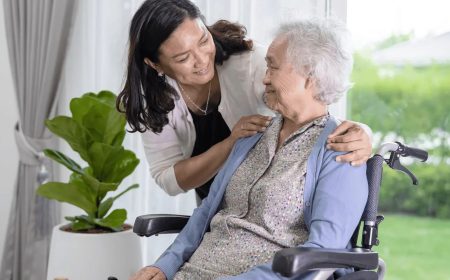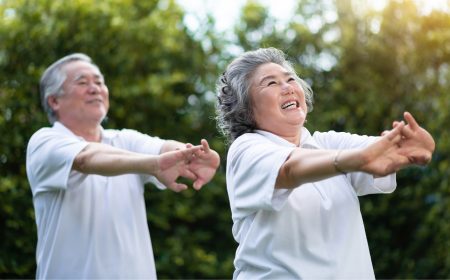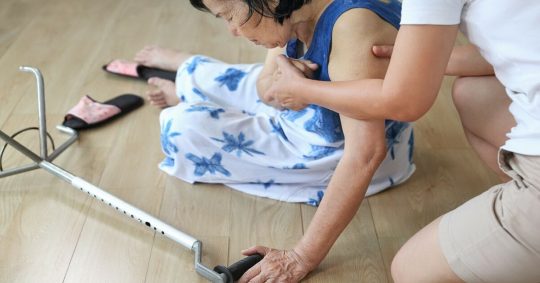
One-third of older people aged 60 and above in Singapore have fallen more than once.
Did you know that about one-third of older people aged 60 and above in Singapore have fallen more than once? While most injuries affecting the elderly are the result of falls, there are steps you can take to mitigate the risk of falls.
Prepare yourself with some tips on how to react if they have a fall, and learn how they can regain their confidence and stay mobile with Rehabilitation and Therapy services.
Jump to the following sections:
What should you do when a fall occurs
If your loved one has had a serious fall such that there is profuse bleeding, fractured bones, immense pain or unconsciousness:
- Stay calm and call 995 immediately
- Unless necessary, do not move them to avoid further injury
- Stop any bleeding by applying firm pressure on the area with a clean cloth or sterile gauze
If your loved one has had a fall with no loss of consciousness and little pain:
- Help them up to a nearby safe spot, such as an armchair with back and arm rests
- Check for physical injuries such as cuts or scrapes, especially if they are on the head
- Monitor them for any weakness in the limbs, blurred vision and light-headedness
- Apply an ice pack wrapped in a towel to the affected area to help with pain and swelling
- Clear up any fall hazards, such as spilt water or clutter.
While your loved ones may reassure you that they are fine after a fall, the accident may have happened due to dizziness and a momentary loss of balance. Consult a doctor for fall-related injuries and screen for any underlying medical conditions, such as low blood sugar or low blood pressure, which are symptoms of diabetes and heart problems.
Check out this video for a step-by-step guide on fall recovery techniques, or keep scrolling to learn about the main causes of falls in elderly and how you can help your loved ones regain confidence.
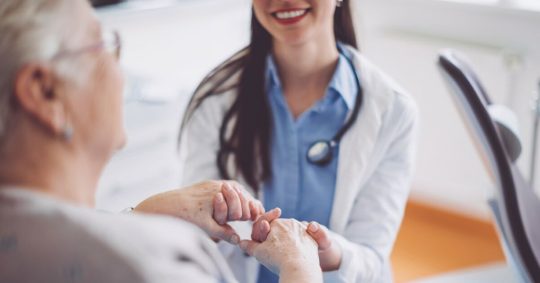
Consult a doctor to understand your loved one’s underlying health issues that may have led to a fall
Main causes of falls in the elderly
A fall can happen to anyone, but the risk increases as one ages. This could be due to physical, medical or environmental factors. Here are some reasons why falls may occur more frequently in older adults:
- Fall hazards in the environment, such as wet bathroom floors, improperly secured carpets or rugs, electrical extensions or uneven sidewalks
- Dizziness or light-headedness from low blood sugar or low blood pressure, especially for individuals with medical conditions such as diabetes and heart disease
- Age-related physical conditions that include weakened muscles, poor coordination, deteriorating vision, impaired sensation in the feet that affects balance
- Impaired movement and balance due to stroke, Parkinson’s disease and arthritis, especially when seniors also have slower reaction time to counter a fall
It is common for seniors with a history of falls to avoid moving about and staying active, as they are worried about falling again. They become less confident to go out of the house and this lack of activity leads to a vicious cycle of seniors having lower stamina and weaker leg and hip muscles, and thus, a higher risk of falls.
How seniors can overcome their fear of falls
Loss of confidence and a fear of falling can linger long after the incident itself. When left unchecked, seniors may limit their movements around the home and community. Prolonged inactivity not only causes the weakening of muscles but also gives rise to long term chronic illnesses, such as osteoporosis, which causes seniors to be more prone to fractures.
Recovering from a fall takes time, effort and determination and NTUC Health can help make the journey a smoother one. That is why starting early on a Rehabilitation and Physiotherapy programme is important for seniors to get back on their feet with confidence.
At our Rehabilitation and Physiotherapy centres, our team of Physiotherapists and Occupational Therapists work with seniors to decrease their fall risk. Physiotherapists will plan an exercise regime focused on strengthening the leg and hip muscles. Seniors can improve their balance and mobility based on a programme tailor-made for their progress.
Interventions may include:
- Movement and balance training
- Endurance and strength training
- Techniques to recover from falls and how to prevent them
- Health and wellness education
- Pain management
- Advice on posture and lifting techniques
- Caregiver training
- Prescription and training on the use of walking aids
Occupational Therapists will provide training to decrease fall risk of seniors while they perform their activities of daily living. Our therapists will also be able to provide guidance on necessary home modifications to reduce fall risk such as the placement of grab bars and night lights.
For elderly persons who have difficulty leaving their home or environment, Home Therapy and tele-rehab are some of the alternative options where they can seek guidance from our team of therapists from wherever they are.
The road to recovery will be easier with support from family. You can assist your loved ones by providing them with a safe environment which will boost their morale and encourage them to take the first step towards a better quality of life.
Client profile: Home Therapy
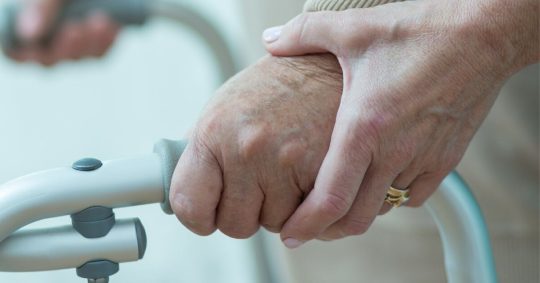
Seek help from our therapists to get your loved ones back on their feet.
In 2019, 75-year-old Mdm Priya* suffered a fall and broke parts of her pelvic bone. Mdm Priya did not undergo surgery and was discharged from the hospital to allow the bones to heal naturally. Prior to the accident, Mdm Priya often went for outings with her family members on a pushchair and spent much of her time doing prayers that required her to stand. Mdm Priya was, however, bedbound after the fall and in a lot of pain.
Her daughter sought help from NTUC Health's Home Therapy service to help with Mdm Priya’s condition. Principal Physiotherapist from NTUC Health, Ms Jean Tan, educated the family on how to manage pain and trained them on supporting Mdm Priya for daily activities such as showering and changing clothes.
Ms Tan also referred the family to occupational therapy when the family sought modifications to their home. Our Occupational Therapist also worked with, Mdm Priya on retraining her to groom herself and change her own clothes.
After four months, Mdm Priya was able to walk along the corridor outside her home, with the help of Jean. She was even able to climb two flights of stairs while holding on to the rails. To continue making progress, she persisted with home exercises with the help of her daughter and domestic helper. Portable ramps were also prescribed to help Mdm Priya to be able to walk or sit on the pushchair to go into the bathroom and toilet.
As Deepavali was around the corner, Mdm Priya’s wish was to be able to put on her own sari by herself. Thankfully, after many months of working hard at rehabilitation and therapy, she was able to dress herself with supervision and enjoy the celebrations with her loved ones.
*This is a case example of how our therapists help clients regain mobility
Summary
Is your loved one prone to falls? We can help with planning a suitable therapy programme to restore their confidence in walking again. Learn more about our Day Rehabilitation and Home Therapy services and drop us an enquiry for centre-based and home-based therapy.

